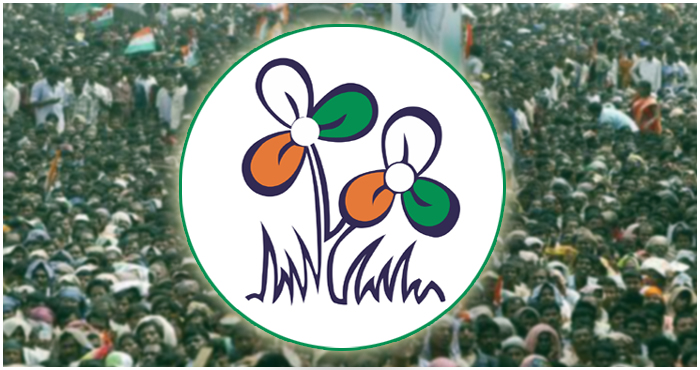Mamata Banerjee had carried out numerous movements in the interest of the people over a period of time, but simultaneously she was realising that to take her movement ahead, she needed a separate platform to raise her voice against the barbaric rule of the CPI(M). Being with the Congress party was becoming a hindrance.
It was this idea and need which gave birth to the Trinamool Congress on January 1, 1998. In 1997, when the Congress convention was going on at Netaji Indoor Stadium, Mamata Banerjee organised an outdoor convention. She believed in working for grassroots people. She wanted to work for common people. That is why she and her compatriots chose the name Trinamool.
The time she chose was the end of the 11th Lok Sabha and the beginning of the 12th Lok Sabha. As a politician of much experience and stature, she understood that it was the right time to launch the party and feel the pulse of the electorate, as people were in admiration of her having seen her work.
Trinamool Congress was established on January 1, 1998. “A silent revolution is taking place in West Bengal. The people are on the verge of writing history… A new epoch will start”, said Chairperson Mamata Banerjee.
On the day of the inception of Trinamool Congress, Mamata Banerjee sketched the logo of the party which signifies ‘grass root’ (two saplings on the grass). She thought if the Election Commission approves the logo then she will achieve two goals: one, the launch of her party and two, of simultaneously taking the philosophy of the party and explaining to the people her deep thought behind the logo, which was the message of secularism, “Ek e brinte duti kusum, Hindu Musalman, ekjon tar noyonmoni onno ti tar pran” (two buds on the tree, Hindu and Muslim. If one of them is the eye, then the other is life).
The Election Commission did approve the logo but had also issued a stricture which read if the Trinamool Congress failed to get six-percentage of votes in the 12th Lok Sabha elections, then the pre-symbol will be cancelled. Trinamool Congress well passed the cut-off percentage and the party was born.
ফিরে দেখা ১লা জানুয়ারী, ১৯৯৮ – কি করে তৈরী হল তৃণমূল কংগ্রেস?
মমতা বন্দ্যোপাধ্যায় তাঁর রাজনৈতিক জীবনের প্রথম থেকেই একের পর এক গণআন্দোলন করেছেন মানুষের স্বার্থে। তবে যত সময় গড়িয়েছে, তিনি ধীরে ধীরে বুঝতে পারছিলেন যে অত্যাচারী সিপিএম-এর নৈরাজ্য থেকে বাংলা ও বাংলার মানুষকে মুক্তি দিতে হলে তাঁর একটি পৃথক মঞ্চ চাই, যেখান থেকে তিনি তাঁর নীতি, সিদ্ধান্ত, বার্তা মানুষের কাছে পৌঁছে দিতে পারবেন, যা তিনি কংগ্রেস দলে থেকে কিছুতেই করতে পারবেন না। এই চিন্তা থেকেই ১৯৯৮ সালের ১লা জানুয়ারি জন্ম নেয় তৃণমূল কংগ্রেস।
১৯৯৭ সালে যখন নেতাজী ইন্ডোর স্টেডিয়ামে কংগ্রেস সম্মেলন চলছিল, মমতা বন্দ্যোপাধ্যায় তখন জনসমক্ষে এক পৃথক সম্মেলনের আয়োজন করেন। তিনি সবসময় তৃণমূল স্তরে সাধারণ মানুষের জন্য কাজ করায় বিশ্বাসী ছিলেন। এই জন্যই তিনি, ও তৎকালীন তাঁর সহ রাজনৈতিক যোদ্ধারা, নতুন দলের নাম রাখেন তৃণমূল।
১১তম লোকসভার সমাপ্তি ও ১২তম লোকসভার শুরু – এই সময়ের সন্ধিক্ষণের সময়টাই তিনি বেছে নিয়েছিলেন। অভিজ্ঞ রাজনীতিবিদ হওয়ার কারণে তিনি অনুধাবন করতে পারেন এটিই সঠিক সময় একটি নতুন রাজনৈতিক দলকে জন্ম দেওয়ার। তিনি এও বুঝেছিলেন, এটি সঠিক সময় সাধারণ মানুষের প্রবণতা বোঝার, কারণ অনেক দিন ধরেই প্রচুর মানুষ তাঁর পরবর্তী রাজনৈতিক পদক্ষেপের জন্য উদগ্রীব ছিলেন।
তৃণমূল কংগ্রেস তৈরী হয় ১৯৯৮ সালের ১লা জানুয়ারি – “পশ্চিমবঙ্গে একটি নিঃশব্দ বিপ্লব শুরু হচ্ছে। মানুষ নতুন ইতিহাস তৈরির দোরগোড়ায়-এক নতুন কাল সৃষ্টি হবে”, নেত্রী মমতা বন্দ্যোপাধ্যায় বলেন।
তৃণমূল কংগ্রেস প্রতিষ্ঠার দিন, মমতা বন্দ্যোপাধ্যায় দলের প্রতীক আঁকেন – ঘাসের ওপর জোড়া ফুল। তৃণমূল দলটি যে ধর্মনিরপেক্ষতায় বিশ্বাসী, সেটিও প্রতিফলিত হবে এই প্রতীকে। ‘মোরা এক বৃন্তে দুটি কুসুম হিন্দু মুসলমান, মুসলিম তার নয়নমণি হিন্দু তাহার প্রাণ।’ এই ছিল এই প্রতীকের বার্তা।
নির্বাচন কমিশন এই প্রতীকটি অনুমোদন করে, কিন্তু, একটি শর্ত দেয়, আগামী লোকসভা নির্বাচনে যদি তৃণমূল কংগ্রেস যদি ৬শতাংশ ভোট না পায়, তাহলে এই প্রতীক বাতিল করে দেওয়া হবে। তৃণমূল খুব সহজেই এই বাধা অতিক্রম করে এবং জন্ম নেয় তৃণমূল কংগ্রেস।


